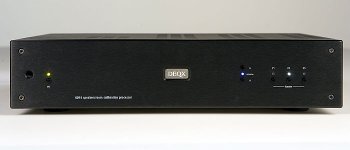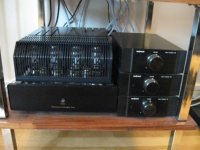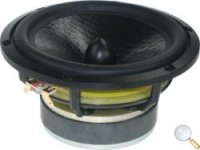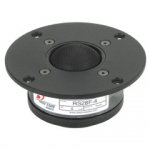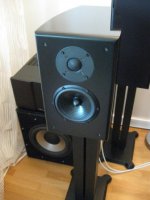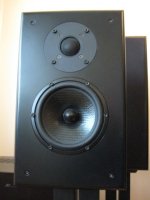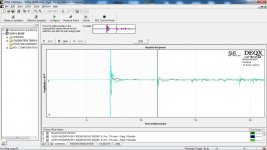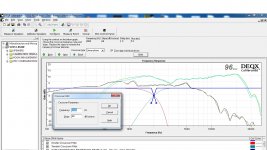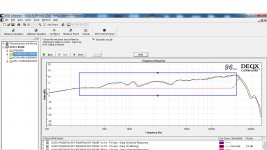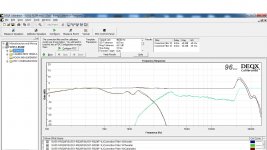Hi,
This time I’m going to share some measurement studies I have done on a test loudspeaker. I set up this loudspeaker to see how my DEQX active-crossover pre-amp behaves.
For those who are not familiar with the DEQX HDP-3 pre-amp, here is some reading on the subject:
DEQX High Definition Audio
In short it has the following capabilities and can be described as follows:
The DEQX unit is one of the more advanced equipment to use when going active, but there are of course others who does similar if not identical stuff like the miniDSP, Holm Acoustics DSPre 1, Beringher dcx2496, Ground Sound and more.
There will be a lot of pictures and measurement graphs etc. and I hope DEQX owners and other people who are interested in going active with similar technologies will find something interesting and useful in this thread. Please, feel free to comment and discuss.
Why go active?
Personally I think an active setup like the DEQX is as fun as doing a passive loudspeaker design, but I realize by reading many audio forums that there are different opinions which way to go – active vs. passive. My opinion is why not both? Both have it strength and weaknesses and when used right, they both can sound great.
Is it easier designing an active loudspeaker using DEQX?
I would say yes and no 😉
Yes, it’s easier to get started with a setup like DEQX with its integrated measurement hardware and software capabilities and to get some fairly decent results.
No, the same rule of physics applies to an active setup as to a passive one. By that I mean you have to consider and deal with baffle step, baffle diffraction, driver distortion and enclosure shape and design as you would have to do in a passive design.
Both an active and a passive design require you to have a decent knowledge about your loudspeakers driver limitations and capabilities. To achieve good or great results you need to have some experience about building loudspeakers.
Because the measurement software supplied with the DEQX is a bit rudimentary, I would say that you should have a separate measurement rig to verify your results with. It also requires you to have fairly high computer knowledge since the DEQX isn’t just a stereo equipment, it also requires you to use a computer to configure it.
To sum it up, I would recommend the following when using the DEQX:
For someone who is not that experienced in designing loudspeakers, the chances of getting a loudspeaker to sound OK is higher with a DEQX system, than building a passive loudspeaker without experience and/or measuring equipment and software. That’s just my own personal reflections 🙂
Picture 1: DEQX HDP-3 Preamp Processor (front).
Picture 2: DEQX HDP-3 Preamp Processor (rear).
Next, measurement setup and equipment……..
This time I’m going to share some measurement studies I have done on a test loudspeaker. I set up this loudspeaker to see how my DEQX active-crossover pre-amp behaves.
For those who are not familiar with the DEQX HDP-3 pre-amp, here is some reading on the subject:
DEQX High Definition Audio
In short it has the following capabilities and can be described as follows:
- Digital cross-over (up to 3-way or 2-way + stereo subs).
- Frequency response correction to within 0.5dB using calibrated mic.
- Phase and time response correction.
- Group delay correction.
- Precise time alignment with zero phase error.
- Linear-phase zero-distortion digital crossovers.
- High-order crossovers up to 300dB/octave eliminate driver interaction.
- Room correction.
- Digital EQ.
The DEQX unit is one of the more advanced equipment to use when going active, but there are of course others who does similar if not identical stuff like the miniDSP, Holm Acoustics DSPre 1, Beringher dcx2496, Ground Sound and more.
There will be a lot of pictures and measurement graphs etc. and I hope DEQX owners and other people who are interested in going active with similar technologies will find something interesting and useful in this thread. Please, feel free to comment and discuss.
Why go active?
Personally I think an active setup like the DEQX is as fun as doing a passive loudspeaker design, but I realize by reading many audio forums that there are different opinions which way to go – active vs. passive. My opinion is why not both? Both have it strength and weaknesses and when used right, they both can sound great.
Is it easier designing an active loudspeaker using DEQX?
I would say yes and no 😉
Yes, it’s easier to get started with a setup like DEQX with its integrated measurement hardware and software capabilities and to get some fairly decent results.
No, the same rule of physics applies to an active setup as to a passive one. By that I mean you have to consider and deal with baffle step, baffle diffraction, driver distortion and enclosure shape and design as you would have to do in a passive design.
Both an active and a passive design require you to have a decent knowledge about your loudspeakers driver limitations and capabilities. To achieve good or great results you need to have some experience about building loudspeakers.
Because the measurement software supplied with the DEQX is a bit rudimentary, I would say that you should have a separate measurement rig to verify your results with. It also requires you to have fairly high computer knowledge since the DEQX isn’t just a stereo equipment, it also requires you to use a computer to configure it.
To sum it up, I would recommend the following when using the DEQX:
- Good computer skills and knowledge.
- Experience in loudspeaker design and physics.
- A measurement rig and equipment to verify the results.
For someone who is not that experienced in designing loudspeakers, the chances of getting a loudspeaker to sound OK is higher with a DEQX system, than building a passive loudspeaker without experience and/or measuring equipment and software. That’s just my own personal reflections 🙂
Picture 1: DEQX HDP-3 Preamp Processor (front).
Picture 2: DEQX HDP-3 Preamp Processor (rear).
Next, measurement setup and equipment……..
Attachments
Both have it strength and weaknesses and when used right, they both can sound great.
What kind of strength do you have in mind when you think of passive systems?

Hi chaparK
Thanks for your input!
You're right; I was pretty vague in my description. It is not always easy to express yourself with nuances of another language. 🙂
I meant the overall concept. One advantage of a passive design is for an example that you do not need extra amps and cables = cheaper. Passive components in the filter also interacts with the driver and changes for an example the Qts value for a driver and thus changes the box size and tuning and can be used to tailor the design to your needs or liking. Likewise using different types of caps etc. can tailor the sound characteristic and your sound preference to some degree, although there are different opinions about this matter. 🙂
As I said, I think both versions are equally fun to work with, but in my experience its how they are used in a design that determines whether they sound good or not.
I hope I make some sense? 😉
Thanks for your input!
You're right; I was pretty vague in my description. It is not always easy to express yourself with nuances of another language. 🙂
I meant the overall concept. One advantage of a passive design is for an example that you do not need extra amps and cables = cheaper. Passive components in the filter also interacts with the driver and changes for an example the Qts value for a driver and thus changes the box size and tuning and can be used to tailor the design to your needs or liking. Likewise using different types of caps etc. can tailor the sound characteristic and your sound preference to some degree, although there are different opinions about this matter. 🙂
As I said, I think both versions are equally fun to work with, but in my experience its how they are used in a design that determines whether they sound good or not.
I hope I make some sense? 😉
Hello gonir,
Thanks for sharing!
Great start to an interesting subject, especially for those of us that don't or have not tried active crossovers.
When I think of active crossovers I think of them either for low crossover points, ie. for subwoofers and or multi-way crossovers, ie. 4-way or more systems. And or use active as a tool to hear a high order crossover vs. low order passive.
Now in a 2-way system it would be interesting to compare active and passive. The U16 and RS28a are good drivers for a 2-way. Were you planning on building a speaker with these or were the drivers dedicated for testing purposes? Thanks.
Thanks for sharing!
Great start to an interesting subject, especially for those of us that don't or have not tried active crossovers.
When I think of active crossovers I think of them either for low crossover points, ie. for subwoofers and or multi-way crossovers, ie. 4-way or more systems. And or use active as a tool to hear a high order crossover vs. low order passive.
Now in a 2-way system it would be interesting to compare active and passive. The U16 and RS28a are good drivers for a 2-way. Were you planning on building a speaker with these or were the drivers dedicated for testing purposes? Thanks.
Hi Gornir (and everybody!). Thanks for answering my question, and thanks for the post in general!
IMHO, the big advantage of passive systems is that speakers and amps are not 'married' forever. So one can buy a sound system at a time, then upgrade to better speakers at a later time and keep the original amp.
Meanwhile active systems are more integrated. For example, if the filtering and the amps share the same power supply and the same chassis, then it's going to be harder to upgrade the speakers separately.
I'm looking forward to reading your next posts!
chaparK
I was expecting that one. However is that really true? When i'm looking at the high cost of crossover components, and at the comparatively low cost of good quality amp power, i tend to think that active designs are actually cheaper...One advantage of a passive design is for an example that you do not need extra amps and cables = cheaper.
These are typically things that you can achieve better with active systems via proper equalization.Passive components in the filter also interacts with the driver and changes for an example the Qts value for a driver and thus changes the box size and tuning and can be used to tailor the design to your needs or liking.
Yes yes 😉Likewise using different types of caps etc. can tailor the sound characteristic and your sound preference to some degree, although there are different opinions about this matter. 🙂
IMHO, the big advantage of passive systems is that speakers and amps are not 'married' forever. So one can buy a sound system at a time, then upgrade to better speakers at a later time and keep the original amp.
Meanwhile active systems are more integrated. For example, if the filtering and the amps share the same power supply and the same chassis, then it's going to be harder to upgrade the speakers separately.
I'm looking forward to reading your next posts!
chaparK
No, I wasn’t planning on building a design using those particular drivers. I just happened to have them available at the moment. 🙂 They are both nice drivers in the same price range and I think they would do fine together in a design.
In my opinion the tweeter is of a quality which would be justifiable in a design with the SEAS W16. I’m thinking perhaps about doing such a design later this summer and I might doing both a passive and active version of it, just for fun 😛
In my opinion the tweeter is of a quality which would be justifiable in a design with the SEAS W16. I’m thinking perhaps about doing such a design later this summer and I might doing both a passive and active version of it, just for fun 😛
Measurement setup and equipment:
This post covers a short description of the equipment and configuration used in the test.
Pre-amp processor and active cross-over:
Amplifiers:
Loudspeaker drivers and enclosure:
Measurement equipment (for verification):
Interconnects:
Cross-over filter and correction settings:
The following general DEQX settings are used in the test:
Next, measurements……..
This post covers a short description of the equipment and configuration used in the test.
Pre-amp processor and active cross-over:
- DEQX HDP-3
- Firmware v63.3.6
- Software v2.58
- Standard calibration kit (calibrated Behringer mic)
Amplifiers:
- 2x PopPulse T150 (class-T stereo amplifier configured as power amps) Picture 1
Loudspeaker drivers and enclosure:
- Woofer: SEAS U16RCY/P (H1520-08) Picture 2
- Tweeter: Dayton RS28F-4 (275-140s) Picture 3
- Enclosure: Parts Express 14 liter curved enclosure (302-721s) Picture 4-5
Measurement equipment (for verification):
- HolmImpulse with M-Audio Audiophile 24/96 soundcard for frequency measurements.
- EMM-8cal and MP-1r calibrated mic and pre-amp. (www.ibf-akustik.de)
Interconnects:
- Loudspeaker Cable: Supra PLY 3.4
- Internal Loudspeaker Cable: Supra PLY 2.0
- RCA Cable: Supra EFF-I + PPSL plugs
Cross-over filter and correction settings:
The following general DEQX settings are used in the test:
- Cross-over type: Linear phase
- Cross-over frequency: 2000Hz
- Cross-over slopes: 60db/oct
- Correction range: 250-20000Hz
- Measurement smoothing: 80%
- Time align individual drivers
Next, measurements……..
Attachments
Could you comment on the steep linear phase slopes used. Any draw backs? I have wanted the DEQX for 4 years now. I have the DCX, MiniDSP, Hypex DSP solutions and Im just waiting for the best DEQX deal. I can do a 60dB slope with cascading functions on the MiniDSP but I do not think I can do a linear phase Slope 🙁
I look forward to your measurements.
I look forward to your measurements.
I know, I Know. I saw that post from you before. 😀 I still didnt know if it had Linear phase brick wall filtering and it does not seem that much cheaper. I thought it was around $1500.
Hi doug20,
In the DEQX world a 60db/oct filter isn’t steep. The default suggested slopes are 96db/oct and can be as high as 300db/oct. In this test I choose 60db/oct slope which is as low as I would use with the DEQX Linear phase setting.
In the DEQX world a 60db/oct filter isn’t steep. The default suggested slopes are 96db/oct and can be as high as 300db/oct. In this test I choose 60db/oct slope which is as low as I would use with the DEQX Linear phase setting.
Yes, I know the DEQX has 300dB slopes.
Was there something you liked more about the 60dB slope over the 300dB slope?
Also I was just looking for a subjective comparison of these steep linear phase slopes vs standard 1st, 2nd or 3rd order BW or LR slopes. I have never heard them so Im curious to what differences exist.
Was there something you liked more about the 60dB slope over the 300dB slope?
Also I was just looking for a subjective comparison of these steep linear phase slopes vs standard 1st, 2nd or 3rd order BW or LR slopes. I have never heard them so Im curious to what differences exist.
here is a review of the Dynacord DSP600, exact same product as the Ev:
http://www.dynacord.com/downloads/Sodru_Dynacord_DSP600_engl.pdf
http://www.dynacord.com/downloads/Sodru_Dynacord_DSP600_engl.pdf
doug20,
I have used both 60, 96, 300 and others slopes in between and they all sound more alike than different. I have used 300db slopes in a 2-way that had an aluminum woofer which had nasty cone break-ups. By using steeper slopes I could use the woofer higher up in frequency, without problem. By using less steep cross-overs, you save processing power and get less delay through the unit. My opinion is if you don't need extremely steep slopes, don't use them. 96db/oct should be fine in most cases.
My experience with the DEQX is that it sounds very neutral, both when used as a pure pre-amp and when used as an active cross-over and correction unit. My conclusion is that the D/A converters used in the DEQX has a very neutral presentation.
It´s all a matter of taste and that's why I have two completely different setups at home. One of them is my DEQX unit together with the PopPulse amplifiers. The other is a setup with a Cambridge DacMagic, Primare Pre30 pre-amp, Prima Luna tube amp or PopPulse amplifier.
With the same loudspeaker they sound quite different. The DEQX more neutral or analytical (in a positive way). The other setup sound more musical and engaging with a huger sound stage.
Which setup do I like more? Actually both, depending on my mood at the moment 🙂
Another observation I have done with the DEQX is, although you use different driver units in a similar setup with the DEQX and using correction and active cross-overs, they sound more alike than different. I cannot say exactly why, but it could be the use of and the characteristic of the Linear phase cross-overs together with the driver correction.
That´s what I have experienced as a DEQX owner for three years, others might disagree and have other experience with the DEQX. 😉
I have used both 60, 96, 300 and others slopes in between and they all sound more alike than different. I have used 300db slopes in a 2-way that had an aluminum woofer which had nasty cone break-ups. By using steeper slopes I could use the woofer higher up in frequency, without problem. By using less steep cross-overs, you save processing power and get less delay through the unit. My opinion is if you don't need extremely steep slopes, don't use them. 96db/oct should be fine in most cases.
My experience with the DEQX is that it sounds very neutral, both when used as a pure pre-amp and when used as an active cross-over and correction unit. My conclusion is that the D/A converters used in the DEQX has a very neutral presentation.
It´s all a matter of taste and that's why I have two completely different setups at home. One of them is my DEQX unit together with the PopPulse amplifiers. The other is a setup with a Cambridge DacMagic, Primare Pre30 pre-amp, Prima Luna tube amp or PopPulse amplifier.
With the same loudspeaker they sound quite different. The DEQX more neutral or analytical (in a positive way). The other setup sound more musical and engaging with a huger sound stage.
Which setup do I like more? Actually both, depending on my mood at the moment 🙂
Another observation I have done with the DEQX is, although you use different driver units in a similar setup with the DEQX and using correction and active cross-overs, they sound more alike than different. I cannot say exactly why, but it could be the use of and the characteristic of the Linear phase cross-overs together with the driver correction.
That´s what I have experienced as a DEQX owner for three years, others might disagree and have other experience with the DEQX. 😉
Another observation I have done with the DEQX is, although you use different driver units in a similar setup with the DEQX and using correction and active cross-overs, they sound more alike than different. I cannot say exactly why, but it could be the use of and the characteristic of the Linear phase cross-overs together with the driver correction.
The DEQX levels the field and pushes only one kind of 'sound' when correctly used - accurate. This is why you find the more often than not the overall tone and presentation are similar between designs. Any real differences in sound now come from power response rather than any on axis performance.
My own experiences have been largely positive with the DEQX itself aside from a general lack of response to emails from the manufacturer which is a shame but its easy to get to grips with the software, just play around till you understand it, nothing to break and once setup you'll never have to touch it again should you wish. The overall sound quality is extremely good, actually too good sometimes because its delivery is very faithful. This is simultaneously its greatest strength and weakness. Furnish it with decent quality recordings and it supplies the essence of music to a degree of realism that's hard to deny but on the flipside if you roll out some internet radio it does sound processed and takes you out of the moment occasionally, perhaps because you know what its capable of more than anything. No fault of the deqx, its just playing back what its given.
So yes its a great bit of kit but if I could have one wish it'd be an accurate way to introduce target curves such as those offered by other XO software. Oh and also to measure harmonic and non linear distortion so I can finally have one box that does it all.
I've decided to go the PC route, using all freeware: Aodix digital workstation software populated with various VST plugins. It's not "convenient", but it offers great flexibility. I'm not to the implementation phase yet (need that fourth amp), but I should have a 4way active passive up and running in the not too distant future.
hope this wasn't too OT
hope this wasn't too OT
doug20,
I have used both 60, 96, 300 and others slopes in between and they all sound more alike than different. I have used 300db slopes in a 2-way that had an aluminum woofer which had nasty cone break-ups. By using steeper slopes I could use the woofer higher up in frequency, without problem. By using less steep cross-overs, you save processing power and get less delay through the unit. My opinion is if you don't need extremely steep slopes, don't use them. 96db/oct should be fine in most cases.
My experience with the DEQX is that it sounds very neutral, both when used as a pure pre-amp and when used as an active cross-over and correction unit. My conclusion is that the D/A converters used in the DEQX has a very neutral presentation.
It´s all a matter of taste and that's why I have two completely different setups at home. One of them is my DEQX unit together with the PopPulse amplifiers. The other is a setup with a Cambridge DacMagic, Primare Pre30 pre-amp, Prima Luna tube amp or PopPulse amplifier.
With the same loudspeaker they sound quite different. The DEQX more neutral or analytical (in a positive way). The other setup sound more musical and engaging with a huger sound stage.
Which setup do I like more? Actually both, depending on my mood at the moment 🙂
Another observation I have done with the DEQX is, although you use different driver units in a similar setup with the DEQX and using correction and active cross-overs, they sound more alike than different. I cannot say exactly why, but it could be the use of and the characteristic of the Linear phase cross-overs together with the driver correction.
That´s what I have experienced as a DEQX owner for three years, others might disagree and have other experience with the DEQX. 😉
Thank you for taking the time to post that. Its exactly the opinion I have been looking for.
The DEQX levels the field and pushes only one kind of 'sound' when correctly used - accurate. This is why you find the more often than not the overall tone and presentation are similar between designs. Any real differences in sound now come from power response rather than any on axis performance.
Hi ShinOBIWAN,
I agree with you and that's my conclusion also, but you explained it better 😉
I must say that my experience with the DEQX team always has been positive. Especially Alan Langford has been helpful and very service minded.
Do you use the "reference calibration kit" or the standard kit? I recently bought the "reference kit" with the DM30 microphone, but I'm still waiting for the DEQX calibration mic file. Hopefully there will be a couple of notch better accuracy with that microphone.
/Goran
Measurements:
Performing measurements with the DEQX is uncomplicated and very straight forward and I won’t go in detail how it works.
The measurements were done under following conditions:
The loudspeaker is placed on stand and mounted on a turn-table jig at a height of 134cm from the floor and measured at the centre of the tweeter. A heavy carpet is placed on the floor between the loudspeaker and the microphone.
The measurements are done at 1 meter at tweeter height for 0 degrees (on-axis), 15 degrees, 22,5 degrees and 30 degrees off-axis. The off-axis measurements are done by turning the turn-table jig to the desired angle. The volume is adjusted to a 90-95db sound pressure. All measurements are repeated for the second loudspeaker.
Speaker calibration (cross-over and speaker correction filter):
I make one correction filter for each measurement angle starting with the 0 degree measurement (picture 1).
I truncate the measurement window just before the first reflection to simulate an anechoic frequency response (picture 2). This measurement is valid down to approximately 260-270Hz.
The measurements are smoothed to 80% which corresponds to somewhere between a 1/12 to 1/24 octave smoothing (picture 3).
Note 1, both left and right loudspeaker drivers are a close match in frequency response.
Note 2, look at the baffle step between 400Hz and 600Hz.
Note 3, look at the woofers extremely linear frequency response between 1.4kHz and 5kHz.
Note 4, look at the effects of the baffle diffraction between 3kHz and 4kHz. More on that later on.
Next I choose the cross-over frequency and slopes, in this case 2000Hz and 60db/oct (picture 4).
Note 5, I choose 2000Hz as a starting point because I know that’s within the drivers “comfort” range, regarding to distortion and dispersion.
Next I choose the correction range, in this case between 250Hz and 20kHz (picture 5).
Note 6, The pink line is the target response.
Note 7, in this case there will be a full baffle step compensation.
Next, the finished target response and correction filter (picture 6). Similar correction filters are made for the 15, 22.5 and 30 degree off-axis measurements.
Next, measurement verification…….
Performing measurements with the DEQX is uncomplicated and very straight forward and I won’t go in detail how it works.
The measurements were done under following conditions:
The loudspeaker is placed on stand and mounted on a turn-table jig at a height of 134cm from the floor and measured at the centre of the tweeter. A heavy carpet is placed on the floor between the loudspeaker and the microphone.
The measurements are done at 1 meter at tweeter height for 0 degrees (on-axis), 15 degrees, 22,5 degrees and 30 degrees off-axis. The off-axis measurements are done by turning the turn-table jig to the desired angle. The volume is adjusted to a 90-95db sound pressure. All measurements are repeated for the second loudspeaker.
Speaker calibration (cross-over and speaker correction filter):
I make one correction filter for each measurement angle starting with the 0 degree measurement (picture 1).
I truncate the measurement window just before the first reflection to simulate an anechoic frequency response (picture 2). This measurement is valid down to approximately 260-270Hz.
The measurements are smoothed to 80% which corresponds to somewhere between a 1/12 to 1/24 octave smoothing (picture 3).
Note 1, both left and right loudspeaker drivers are a close match in frequency response.
Note 2, look at the baffle step between 400Hz and 600Hz.
Note 3, look at the woofers extremely linear frequency response between 1.4kHz and 5kHz.
Note 4, look at the effects of the baffle diffraction between 3kHz and 4kHz. More on that later on.
Next I choose the cross-over frequency and slopes, in this case 2000Hz and 60db/oct (picture 4).
Note 5, I choose 2000Hz as a starting point because I know that’s within the drivers “comfort” range, regarding to distortion and dispersion.
Next I choose the correction range, in this case between 250Hz and 20kHz (picture 5).
Note 6, The pink line is the target response.
Note 7, in this case there will be a full baffle step compensation.
Next, the finished target response and correction filter (picture 6). Similar correction filters are made for the 15, 22.5 and 30 degree off-axis measurements.
Next, measurement verification…….
Attachments
- Status
- Not open for further replies.
- Home
- Loudspeakers
- Multi-Way
- SU551-RS28F – a 2-way DEQX system loudspeaker measurement study
